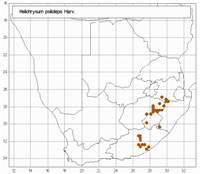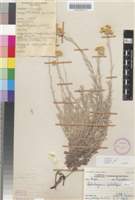Origin of name:
psilo = bare, bald, smoothlepis = scales
Diagnostic characters:
Large headsOpen branched inflorescenceBright yellow bractsOuter bracts brown-tipped
Description:
Tufted perennial herb, stems many from a rhizomatous stock, erect, or ascending to 400 mm, simple or branched from the base, greyish-white woolly, closely leafy throughout. Leaves up to 30 x 4 mm, but often only c. 15 x 2 mm, linear or linear-lanceolate, apex acute, mucronate, base broad, half-clasping, both surfaces greyish-white woolly. Heads heterogamous, campanulate, c. 5 mm long and as broad, many in congested terminal rounded corymbose clusters 15�20 mm across. Involucral bracts in c. 7 series, 4 inner subequal, loosely imbricate, tips slightly exceeding flowers, obtuse, pellucid, canary-yellow, crisped, slightly radiating, outer tipped pale golden-brown, bases woolly. Receptacle minutely tuberculate. Flowers 112�156, 54�81 female, 62�102 homogamous, female very rarely outnumbering homogamous. Achenes not seen, ovaries with myxogenic duplex hairs. Pappus bristles many, equaling corolla, scabrid, bases cohering by patent cilia.
Flowering between November and January.
Distribution:
Grows in grassland. Ranges from Vereeniging, Standerton and Wakkerstroom in Mpumalanga through Dundee, Newcastle and Utrecht districts in northern KwaZulu-Natal to the mountainous NE. corner of the Free State, western Lesotho, and the E. and E. central Cape as far west as the mountains about Graaff-Reinet and the Suurberg north of Port Elizabeth, between c. 600 and 2 100 m.
Grassland, Savanna and Thicket Biomes.
Taxonomy:
Literature:
Helichrysum psilolepis Harv. in F.C. 3: 235 (1865); Moeser in Bot. Jb. 44: 285 (1910); Hilliard, Compositae in Natal 207 (1977).
Type:
Lectotype: Cape, between Zwart Kei and Stormberg, Dr�ge 3755 (G-DC).
Synonym(s):
H. adscendens sensu DC., Prodr. 6: 185 (1838), non (Thunb.) Less.
Vouchers:
Acocks 18675 (PRE); Dieterlen 143 (NBG); Flanagan 363 (PRE, SAM); Galpin 9811 (PRE); Hilliard & Burtt 10975 (E; K; MO; NU; S).
_sml.jpg)
_sml.jpg)
_sml.jpg)
_sml.jpg)
